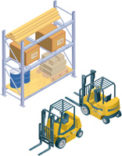lean fleets

With peak season around the corner, a supervisor puts in a call for several lift truck rentals. The trucks arrive and are immediately put to use. After the busy season, the supervisor leaves the company for another job. But the rented trucks stay in the fleet for weeks, maybe months, and the rents continue to mount. No one in the operation seems aware that the rented vehicles are not part of the regular mix of leased and owned vehicles. Supervisors authorize payments for maintenance. And accounts payable routinely sends a check to the rental company and never bothers to ask why the DC still has the equipment.
Sound far-fetched? Fleet management specialists say stories like that are more common than you might think. With DC managers focused first on moving product, fleet productivity and efficiency can easily become secondary issues.
But with the current intense pressure to reduce costs in a poor economy, now may be a good time to take a close look at the lift truck fleet to determine if you have the right equipment in the right place at the right price. And, indeed, fleet management specialists say they've seen renewed interest in fleet optimization from customers.
"More so than ever," says Scot Aitcheson, vice president of sales and marketing for Yale Materials Handling Corp. "Customers were not necessarily focused on fleet management a year or two ago. Now, if there is a possibility to save a penny, they are looking for that."
"Capital expenditures are pretty tight right now, so businesses are going to focus on keeping their trucks going as long as possible," adds Joe LaFergola, manager of fleet operations for Raymond Corp. "It is important to have a sound model for understanding whether it is [more cost effective] to keep a truck or replace it."
Details, details
Implementing a fleet management program can provide savings in any financial environment, says
Mike McKean, manager of fleet management sales and marketing for Toyota Material Handling,
U.S.A. But potential cost-savings come into much sharper focus in a slow economy. The question
is how to find those opportunities.
DC managers can start the process of analyzing their fleets on their own, particularly in small or single-site operations. For bigger operations, it's a bit trickier. But there are places they can turn for help. Most lift truck OEMs offer fleet management services in addition to their equipment lines. Independent fleet management companies also provide services that include fleet evaluations.
These companies offer a number of suggestions on how to proceed with evaluating the current fleet, implementing changes to it, and then keeping the fleet fine tuned. For example, John Russian, manager of fleet marketing for Hyster Co., says his company suggests a five-step process that begins with a survey of current operations, followed by analysis, proposing changes, implementation, and monitoring results.
The first step sounds simple enough, but taking a vehicle count can actually be somewhat complicated for companies with large fleets across multiple locations. Jason Bratton, vice president of business development for BEB Fleet Source Group, which helps clients evaluate their fleets and implement fleet management strategies, says that in order to get an accurate tally, his company literally counts the vehicles in a facility and then works with the customer's dealer to see what's on the books.
Russian says that along with determining the number of trucks in use, the equipment audit should include a detailed accounting of the vehicles' age, operating hours, make and model, and aftermarket attachments. Other questions to ask include: What equipment is owned, what is leased, what is rented? What has existing warranties? What equipment is fully depreciated?
Critical, too, is information on the number of operators and the configuration of the facility. And changes made in the layout of the facility need to be understood. Does it have more narrow aisles, for instance, or raised racks?
Russian also recommends gathering the maintenance history for each truck in the fleet. "The customer may have a total, but not get granular," he says. "We need a good understanding of what is being spent on a specific truck."
The initial survey should also include a careful look at how vehicles in the fleet are actually being used. To help gather the necessary data, several companies have developed remote monitoring systems that automatically collect, transmit, and analyze data about vehicle performance and productivity. Crown Equipment Corp., for instance, offers a wireless fleet management system that captures a variety of operational data from meters installed on the trucks. Matt Ranly, Crown's senior marketing product manager, says the system provides detailed information on how each truck is being used. "It feeds that data back to the warehouse manager so he can make good decisions about equipment."
The results of these studies sometimes contain surprises. Aitcheson of Yale tells of one customer, a manufacturer, that was using one lift truck as a lift table. You may find multiple trucks assigned to tasks where one would do, or trucks that are idle much of the time. And a careful survey may expose other facility issues. For instance, a search for the root cause of high tire expenditures might reveal flooring or dock or drain problems that require attention.
Aitcheson notes that it's important to allow several weeks for the monitoring process. He suggests conducting an evaluation over a 30- or 60-day period to get an accurate picture of fleet operations.
Analyze this
It's not enough to just collect operating data; you have to analyze it as well. That can be done a number of ways. For example, Raymond's approach to analyzing fleet utilization is to look at deadman hours per day. A "deadman" is a safety device on all modern lift trucks that must be engaged by the operator for the vehicle to operate. It might be the pedal in a lift truck or a handle on a pallet jack. "When the deadman is engaged, the vehicle is doing work," LaFergola says. "In an eight-hour shift, that can be anywhere from two to five hours."
Bratton says that his company uses the results of its fleet surveys to calculate each truck's cost per operational hour— including maintenance costs. "We need to get the information for a set period of time," Bratton says. BEB has developed analytical software to help derive the cost per hour for each piece of equipment in a customer's operations.
Hyster concentrates on usage patterns. "We look at the inventory summary, the department summary and we get to the granular level," says Russian. "Are trucks used in shipping or receiving? Are they used in freezer applications? Are they used in production? We look for redeployment or retirement opportunities. We look for short-term rentals being used for longterm use, which is not advantageous."
That may sound like a lot of work, but the payoff can be big. Bratton reports that in his experience, fleet utilization analyses almost invariably reveal savings opportunities. "In almost every case, we find there is too much equipment," he says. And often, the trucks in the fleet are bigger than they need to be. That happens as DC operations change over time, he explains. "DCs often buy a forklift that's just like the old forklift, but the job has changed."
What's it all mean?
With detailed information on the existing fleet in hand, the next step is to determine what the fleet should look like and how to get there. Part of that process is deciding what equipment needs to be replaced and establishing a schedule for that. Bratton advises fleet managers to determine a metric for cost per operating hour specific to their own operation to help guide future equipment replacement decisions. The goal, he says, is to develop a plan to ensure that the fleet is operating at the lowest possible cost with the highest possible equipment utilization.
As for what the optimal cost might be, Bratton says there is no "magic cost per hour." The nature of an operation, the condition of the facility, and other factors create great variability.
LaFergola agrees that the type of operation has a big effect on the cost per deadman hour. "Grocery operations will be higher than pharmaceuticals," he says. "Pharma operations are clean, they have an immaculate product, and the product is light. Grocery products are heavy, the warehouses are not as clean and the floors are not as smooth, and throughput is running full bore, so the cost per hour is going to be higher."
The end result of the analysis should be a comprehensive plan that includes details on retiring and replacing lift trucks in the fleet. In some cases, Russian adds, the plan might also call for redeploying trucks. "The best use may not be in that given facility," he explains.
Put it to work
Once a plan has been drawn up, the all-important implementation stage follows. "The customer can begin right sizing the fleet based on the operation and any finance options that may be available," says Russian. For example, one fleet manager may choose to outsource maintenance at a fixed monthly cost, while another may opt to have maintenance billed on an hourly usage basis, and a third may elect to handle maintenance in house. Each of those has cost implications that must be clear at the outset. And the decision must fit with the DC management's comfort level.
A thorough fleet evaluation, development of a plan for change, and implementing that plan can take several months. And the plan could have some upfront costs of its own for such things as fleet management software or electronics to keep detailed records on truck use.
Implementation steps may also be limited by financial factors, such as time remaining on the leased vehicles' contracts or depreciation remaining on owned vehicles. And it requires a commitment by management at all levels. "The key piece to that is the customer actively responding to recommendations," says Aitcheson. "That can be very difficult." Often, he says, managers have grown accustomed to having more backup equipment available than is strictly necessary. So implementing a successful program may require a shift in attitudes as well—likely driven by executive management insistence.
Still, the rewards can be substantial. Aitcheson estimates that customers on average save about 15 percent on overall fleet costs within the first year. And that should be just the beginning.
All of the fleet management specialists interviewed for this article stress that fleet managers have to build into their operations a way to perpetually evaluate and improve their fleets. "You can get the fleet right sized, then it can get fat over time," says McKean. "What are you going to do to retain, retire, and redeploy equipment on a consistent basis?"
The ongoing monitoring should include regular tracking of truck utilization, maintenance costs, and operational issues such as lift truck accidents and their causes. "It is important to have the tools to segment where the money is going—tire expenses, rack damages, and so on—to make intelligent decisions," Russian says.
Aitcheson adds that nowadays, fleet managers can obtain reports that break down spending by facility, by vehicle, even by specific components. Managers can also get reports that compare facilities or that break out top component issues or damage issues, he says. "That's where fleet management really takes off."
Ongoing improvements are the key to long-term gains, Aitcheson says. And long-term gains are what smart managers should be aiming for. "Everyone is tightening their belt this year," he says. "But you want benefits for the next three, five, seven years."
Related Articles

Copyright ©2024. All Rights ReservedDesign, CMS, Hosting & Web Development :: ePublishing